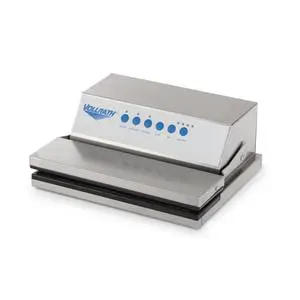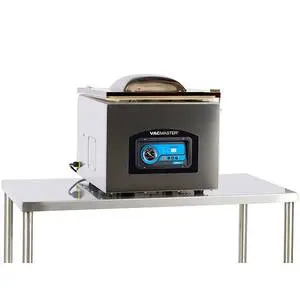Vacuum Sealers are quickly becoming an integral part of many commercial kitchens for several reasons. Often the primary reason for adding a vacuum sealer to one’s kitchen is for sous vide cuisine; a modern cooking technique literally translated to under vacuum. These machines have a number of other benefits when used in the commercial kitchen. When used for storage, the right machine can help cut food cost, aid in the storage and organization of inventory, and maximize flavor transfer when marinating product.
Two basic styles of vacuum sealing machines
There are two basic design types for vacuum sealers: external machines or chamber style machines. While both essential perform the same function, they do so in a different way.
External machines are typically smaller, lighter and a more economical choice. They perform best when primarily used for storage, portion control, and basic sous vide applications. The product is placed in the vacuum bag, the open end of the bag is fed into a slot where the machines pump motor removes air and then seals the bag closed.
Chamber style machines perform in the same manner, except the product and bag are placed directly inside a chamber where the air is removed from the bag prior to being sealed. This allows wet product to be sealed (stocks, sauces, products with wet marinades, etc.) as well as solid items.
Storage benefits of utilizing a vacuum sealer
Operators can dramatically lower their food cost by installing a vacuum sealer in their kitchen. By storing center of plate proteins in an anaerobic environment and implementing proper product rotation, spoilage can virtually be eliminated. Seafood can be sealed in bags to eliminate water damage when being stored on ice. Items can be portioned and individually packaged to aid in inventory control and organization. Bulky stocks and sauces can be processed and packaged in pouches that lay flat and stack well in coolers and freezers.
Sous Vide
Quickly becoming a popular cooking method, sous vide cuisine offers chefs far more control over their product than most other methods. The basic principle behind this style of food is cooking in a pouch under vacuum, typically in a moist environment. This accomplishes two main goals: uniform and even heat distribution to the product, as well as minimal shrinkage and loss (as the natural juices from the item virtually have nowhere to go). Typically, the cooking equipment used for sous vide, immersion circulators, C- Vaps, and combi ovens, offer the chef precise temperature control and add unparalleled consistency to the finished product.



